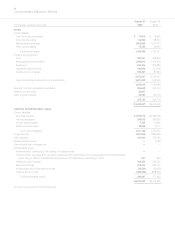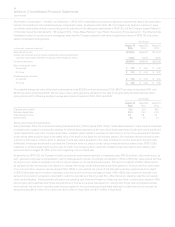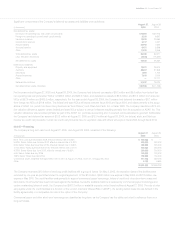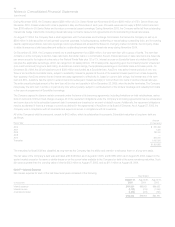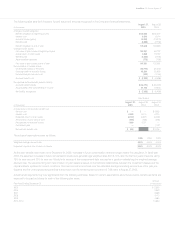AutoZone 2005 Annual Report Download - page 39
Download and view the complete annual report
Please find page 39 of the 2005 AutoZone annual report below. You can navigate through the pages in the report by either clicking on the pages listed below, or by using the keyword search tool below to find specific information within the annual report.
AutoZone ’05 Annual Report 29
Revenue Recognition
The Company recognizes sales at the time the sale is made and the product is delivered to the customer. Revenue from sales are presented net of
allowances for estimated sales returns, which are based on historical return rates.
Vendor Allowances and Advertising Costs
The Company receives various payments and allowances from its vendors based on the volume of purchases and for services that AutoZone
provides to the vendors. Monies received from vendors include rebates, allowances and promotional funds. The amounts to be received are
subject to purchase volumes and the terms of the vendor agreements, which generally do not state an expiration date, but are subject to ongoing
negotiations that may be impacted in the future based on changes in market conditions, vendor marketing strategies and changes in the profitability
or sell-through of the related merchandise. The Company’s level of advertising and other operating, selling, general and administrative expenditures
are not dependent on vendor allowances.
Rebates and other miscellaneous incentives are earned based on purchases or product sales and are accrued ratably over the purchase of the
related product, but only if it is reasonably certain that the required volume levels will be reached. These monies are recorded as a reduction of
inventories and are recognized as a reduction to cost of sales as the related inventories are sold.
For all allowances and promotional funds earned under vendor funding arrangements entered into or modified after December 31, 2002, the
Company applied the guidance pursuant to the Emerging Issues Task Force Issue No. 02-16, “Accounting by a Customer (Including a Reseller)
for Cash Consideration Received from a Vendor” (“EITF 02-16”), by recording the vendor funds as a reduction of inventories that are recognized
as a reduction to cost of sales as the inventories are sold. The Company’s vendor funding arrangements do not provide for any reimbursement
arrangements that are for specific, incremental, identifiable costs that are permitted under EITF 02-16 for the funding to be recorded as a reduction
to advertising or other operating, selling, general and administrative expenses.
Prior to applying EITF 02-16, certain vendor allowances and promotional funds earned under vendor funding arrangements entered into before
December 31, 2002 were recognized as a reduction to advertising and other operating, selling, general and administrative expenses. Subsequent
to fiscal 2003, vendor allowances did not reduce advertising or other operating, selling, general and administrative expenses, as all vendor funding
arrangements entered into prior to December 31, 2002 had been modified or had expired. Vendor funding arrangements reduced advertising expense
by $44.0 million in fiscal 2003, resulting in net advertising expense of $32.5 million. Advertising expense was approximately $90.3 million in fiscal
2005 and $98.1 million in fiscal 2004. The Company expenses advertising costs as incurred.
Warranty Costs
The Company or the vendors supplying its products provide its customers with limited warranties on certain products. Estimated warranty obligations
for which the Company is responsible are based on historical experience, provided at the time of sale of the product, and charged to cost of sales.
Shipping and Handling Costs
The Company does not generally charge customers separately for shipping and handling. The cost the Company incurs to ship products to the
stores for delivery to the customer is included in cost of sales.
Pre-opening Expenses
Pre-opening expenses, which consist primarily of payroll and occupancy costs, are expensed as incurred.
Earnings Per Share
Basic earnings per share is based on the weighted average outstanding common shares. Diluted earnings per share is based on the weighted
average outstanding shares adjusted for the effect of common stock equivalents. At this time, stock options are the Company’s only common stock
equivalents. Stock options that were not included in the diluted computation because they would have been anti-dilutive were approximately 1.0
million shares at August 27, 2005.
Stock Options
At August 27, 2005, the Company has stock option plans that provide for the purchase of the Company’s common stock by some of its employees
and directors, which are described more fully in “Note H—Employee Stock Plans.” The Company accounts for those plans using the intrinsic-value-
based recognition method prescribed by Accounting Principles Board (“APB”) Opinion No. 25, “Accounting for Stock Issued to Employees,” and
related interpretations. Accordingly, no stock-based employee compensation cost is reflected in net income, as options are granted under those plans
at an exercise price equal to the market value of the underlying common stock on the date of grant. Statement of Financial Accounting Standards
No. 123, “Accounting for Stock-Based Compensation” (“SFAS 123”), and Statement of Financial Accounting Standards No. 148, “Accounting for







